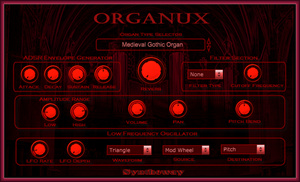Drawbar Organs
Antique, Classic, Vintage and Modern Virtual Organs
VST VST3 Audio Unit


Overview
Organux is a virtual
instrument designed for creating a wide range of antique, classic, vintage and modern
organs covering a vast array of sounds. From a metal or wood pipe type, going
through a free-reed, to an electronic, analogue electronic and digital organ
types. Versatile for any
genre of music, be it classical, rock, jazz, blues, soul, liturgical, gospel, funk, R&B, pop,
techno, electronic, dance, new age and world among others.
Available as plugin in VST 32 bit and 64 bit
and VST3 64 bit
versions for
Windows / Audio Unit, VST and VST3 for
macOS.
Features
• Quick selector to switch between 30 different preset sounds:
|
# |
List of Preset Sounds / Demo
↓ |
 |
|
1 |
Cathedral Organ |
 |
|
2 |
Chapel's Baroque Organ |
 |
|
3 |
Church
Organ |
 |
|
4 |
Medieval
Gothic Organ |
 |
|
5 |
Renaissance Pipe Organ |
 |
|
6 |
Dark
Dissonant Pipe Organ |
 |
|
7 |
Portable
Harmonium |
 |
|
8 |
Pump Reed
Organ |
 |
|
9 |
Blues Organ |
 |
|
10 |
Chorus Organ |
 |
|
11 |
Mellow Rock Organ |
 |
|
12 |
Percussive Organ |
 |
|
13 |
Circus Steam Calliope |
 |
|
14 |
Ethereal Organ |
 |
|
15 |
Glassy Ambient Organ |
 |
|
16 |
New Age Organ |
 |
|
17 |
Organicus |
 |
|
18 |
Organum |
 |
|
19 |
Synthesizer Organ |
 |
|
20 |
Vibraphorgan (Organ Vibes) |
 |
|
21 |
Hammond B3 (Fast Leslie Speed) |
 |
|
22 |
Hammond B3 (Slow Leslie Speed) |
 |
|
23 |
Korg O1-WProX Fantasy Organ |
 |
|
24 |
Oberheim OB-3 Organ |
 |
|
25 |
Yamaha CN-70 Organ |
 |
|
26 |
Elka
Panther (Transistor Combo) |
 |
|
27 |
Farfisa Compact Organ |
 |
|
28 |
VOX Continental (Transistor
Combo) |
 |
|
29 |
VOX Corinthian (Transistor
Combo) |
 |
|
30 |
VOX Jaguar (Transistor Combo) |
 |
|

VST
is a trademark of Steinberg Soft- und Hardware GmbH

